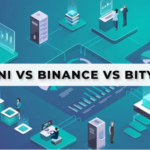If you’re running Ethereum validators, you probably live in beaconcha.in already. It’s the default way to check balance, uptime, and whether your nodes are behaving.
But the moment you or your accountant try to turn all those tiny reward events into a clean report, you hit a wall:
- Thousands of micro-payouts per validator
- Rewards split across consensus and execution layers
- Multiple validators, fee recipients, and wallets
- Different tax years and reporting formats
Most tax authorities treat staking rewards as taxable income when you receive them, and then expect capital gains calculations when you later sell or swap that ETH. For that, you need full, accurate, historical and realtime data not just a nice dashboard.
This is where Bitquery’s Ethereum Chain APIs & Streams comes in as the beaconcha.in alternative on the data side: their easy to integrate GraphQL API and Streams provide you validator balances and individual rewards in both ETH and USD(fiat) denomination without any oracle integration, ready for tax tooling.
Why Beaconcha.in is Not Enough
For monitoring a handful of validators, it’s perfect. However, explorers like beaconcha.in are fundamentally UI-first tools:
- Optimized for human browsing, not bulk data extraction
- Focused on real-time and recent history, not multi-year archival exports
- Not designed as your main ETL pipeline for tax, accounting, or BI systems
Enterprise reporting, on the other hand, wants:
- Every reward event
- Every withdrawal
- Every relevant execution-layer reward (tips / MEV)
- All of it timestamped, valued in fiat, and exportable at scale
If your goal is tax-grade validator reporting, here’s the minimum viable dataset you need and how Bitquery maps to it.
Table of Contents
Why Bitquery Is the Best Beaconcha.in Alternative
Bitquery is purpose-built for builders who need streaming-grade, tax-ready data rather than dashboards. You get:
Data completeness: All validator actions including block proposals, withdrawals, and transaction fees come with balance change reason codes so nothing falls through the cracks.
Native USD valuations: Every balance change arrives with PostBalanceInUSD, powered by Bitquery’s own Crypto Price API, so accountants never chase oracle feeds.
Real-time Streams: Access data from Ethereum genesis and keep the firehose running via GraphQL subscriptions or Kafka topics.
1. Consensus Layer Rewards (Block Proposals)
What you need: Every time your validator proposes a block, you receive a reward. This needs to be tracked with: – Exact timestamp – ETH amount – USD value at time of receipt – Validator address – Block number
How Bitquery delivers: Use the Ethereum Validator Balance Tracker API with BalanceChangeReasonCode 2 (BalanceIncreaseRewardMineBlock). The ready-to-run IDE example is here: Track Validator Rewards.
2. Beacon Chain Withdrawals
What you need: When ETH is withdrawn from the beacon chain to your execution layer address, this is a taxable event. Track: – Withdrawal timestamp – ETH amount withdrawn – USD value at withdrawal time – Source validator – Destination address
How Bitquery delivers: Filter for BalanceChangeReasonCode 3 (BalanceIncreaseWithdrawal). Test it in the IDE with Track Validator Balance Updates.
3. Execution Layer Rewards (MEV/Tips)
What you need: Transaction tips and MEV rewards are separate from consensus rewards and often the largest income source. Track: – Each tip/MEV event – Timestamp – ETH and USD amounts – Block builder address – Transaction hash
How Bitquery delivers: Use BalanceChangeReasonCode 5 (BalanceIncreaseRewardTransactionFee) to track all execution layer rewards. Run the Top Validators by Total Tips in Last 24h or Total Tips for a Validator examples for instant data.
4. USD Valuation Without Oracle Integration
What you need: Every reward event needs a USD value at the time it was received for tax reporting. Most APIs require separate oracle calls or price feeds.
How Bitquery delivers: The PostBalanceInUSD field is automatically included in every balance change response. No additional API calls or oracle integration needed. The USD values are calculated using Bitquery’s Crypto Price API, which aggregates prices across multiple DEXs and provides historical price data.
5. Real-time Streaming for Ongoing Monitoring
What you need: For active monitoring and near real-time reporting, you need streaming data, not just periodic polling.
How Bitquery delivers: Convert any query to a real-time stream by changing query to subscription. Follow the WebSocket quickstart or the Kafka streaming guide and plug in the validator templates from the IDE links above.
Key Advantages Over Beaconcha.in for Data Extraction
- API-First Design: Built for programmatic access, not just UI browsing
- USD Values Included: No separate oracle integration needed
- Historical Data: Access to all historical validator data, not just recent events
- Real-time Streaming: WebSocket subscriptions for live monitoring
- Multiple Validators: Query across all your validators and fee recipients in one call
- Export Ready: Structured JSON/CSV output perfect for tax software integration
- Enterprise Scale: Handle thousands of validators and millions of reward events
Open-Source Dashboard Option

Want a turnkey UI that already uses these APIs? Check the application Ethereum Validator Rewards Tracker. The Next.js dashboard streams validator balances, shows 24h deltas, includes pagination/export tooling, and exposes CSV downloads which is perfect if you need a self-hosted front end for compliance or accounting teams. Grab the code at validator-data-dashboard and plug in your Bitquery token to get started. You can start integrating their SDK to fasten the development.









